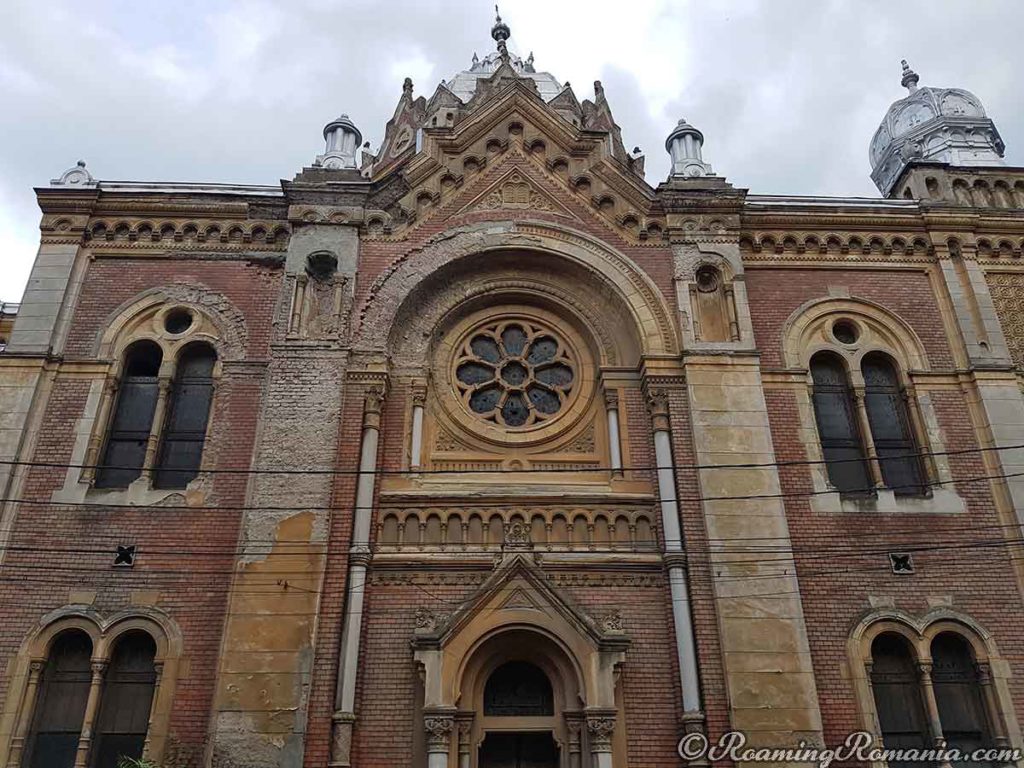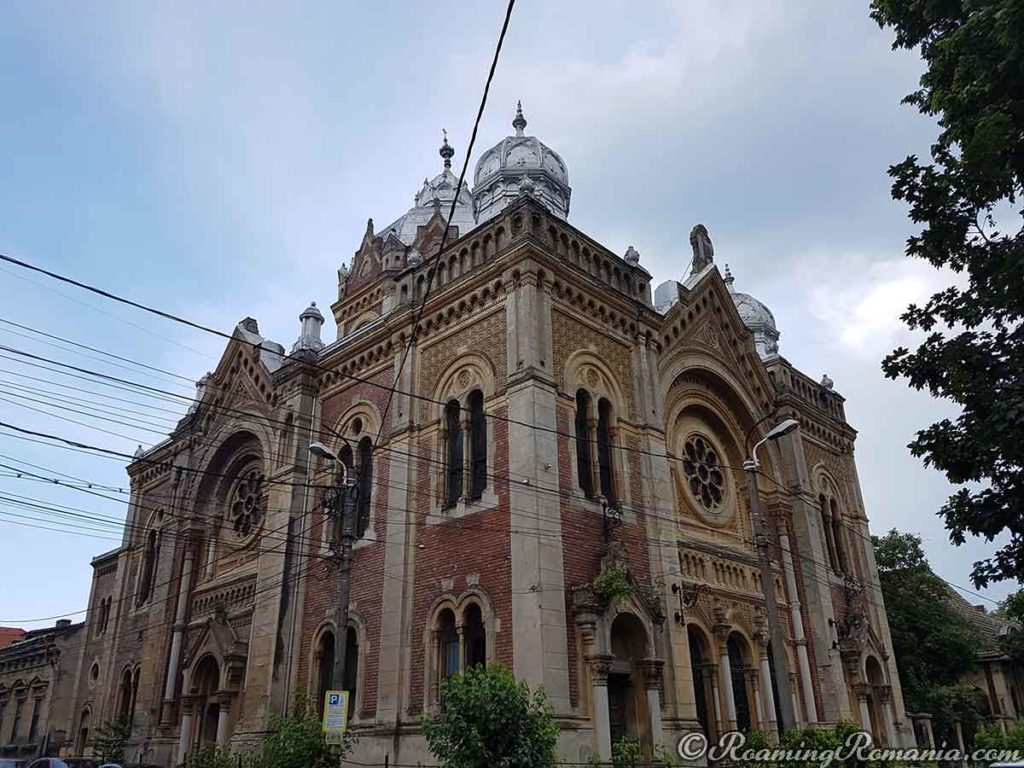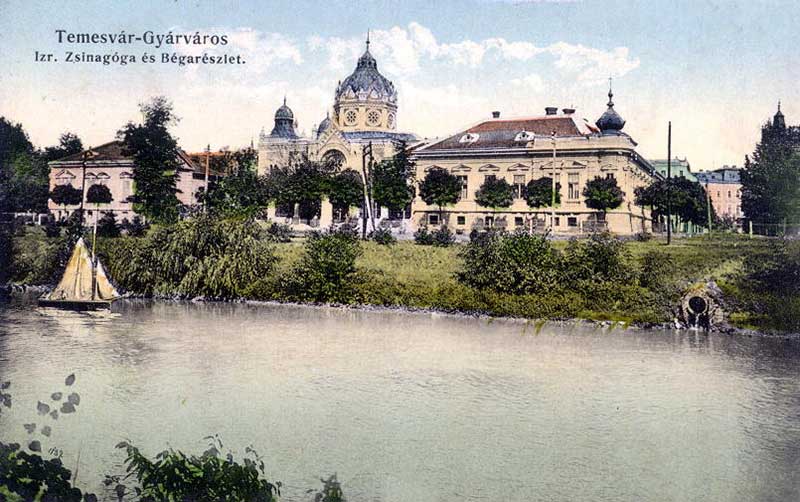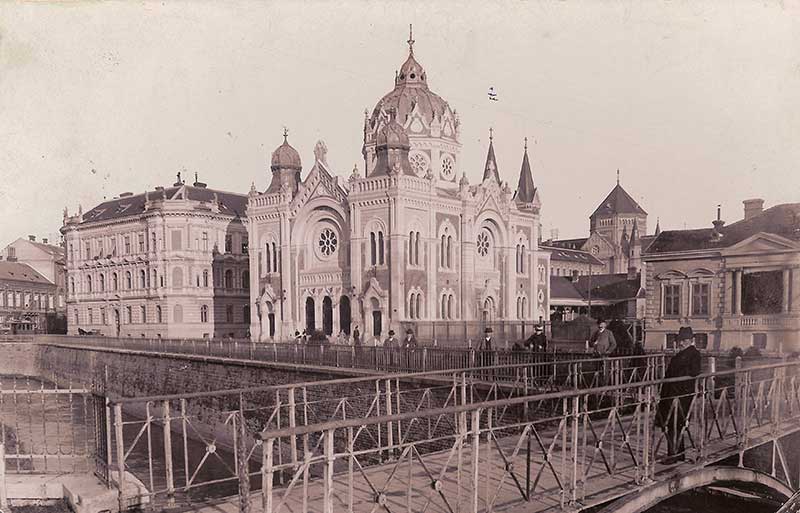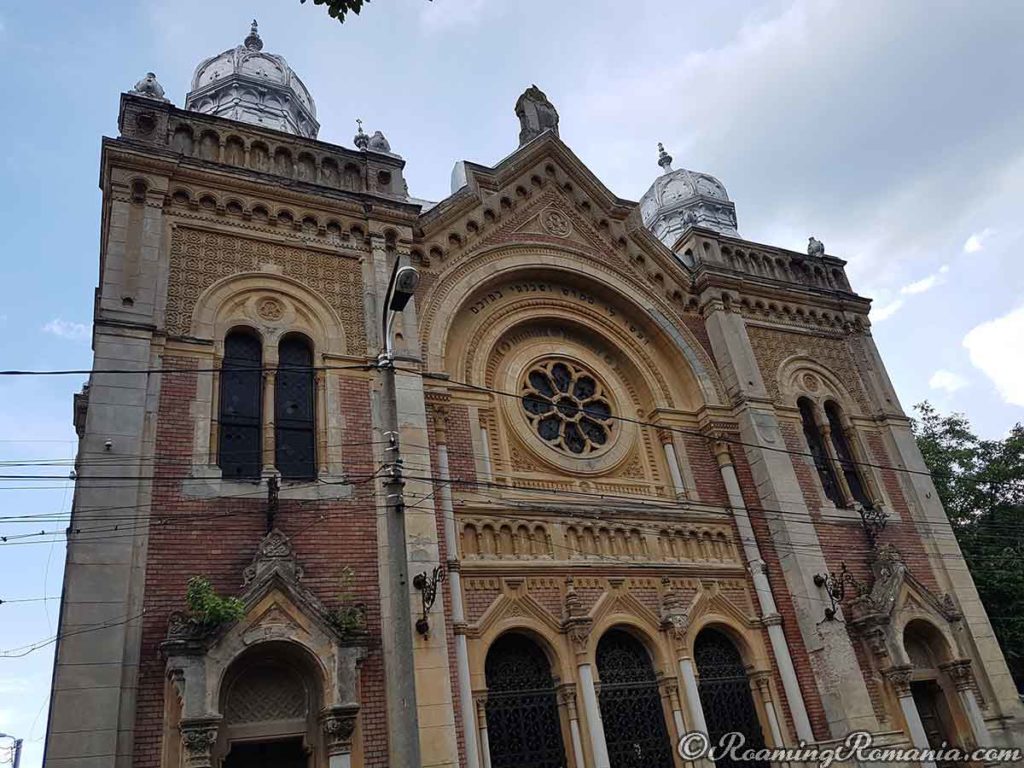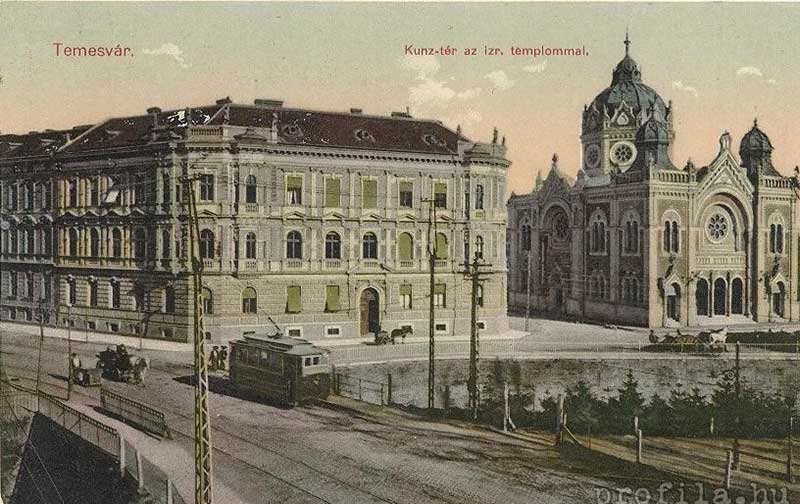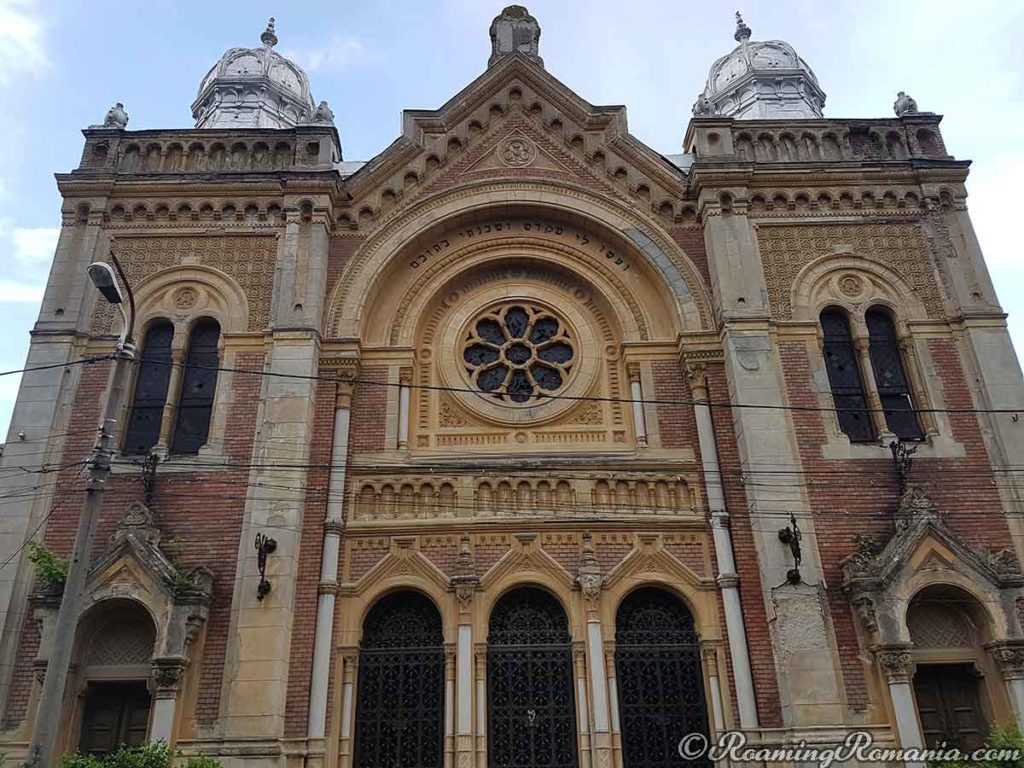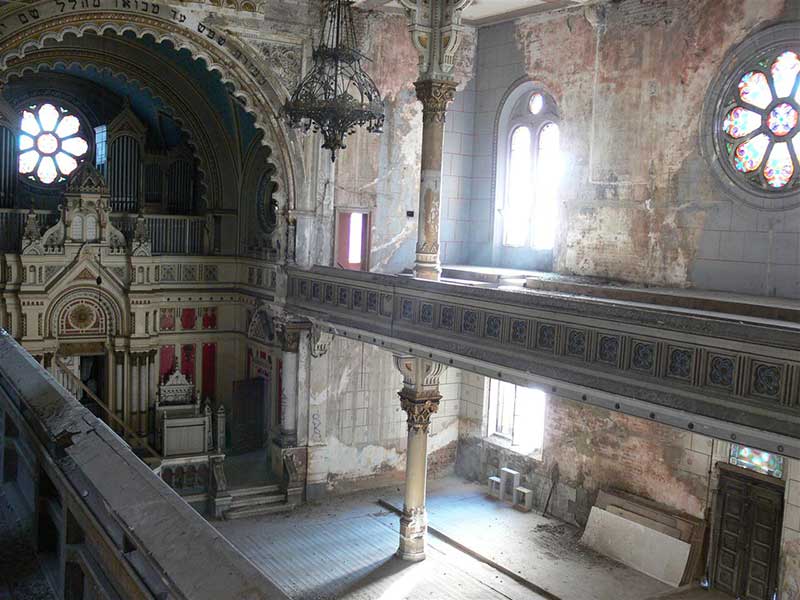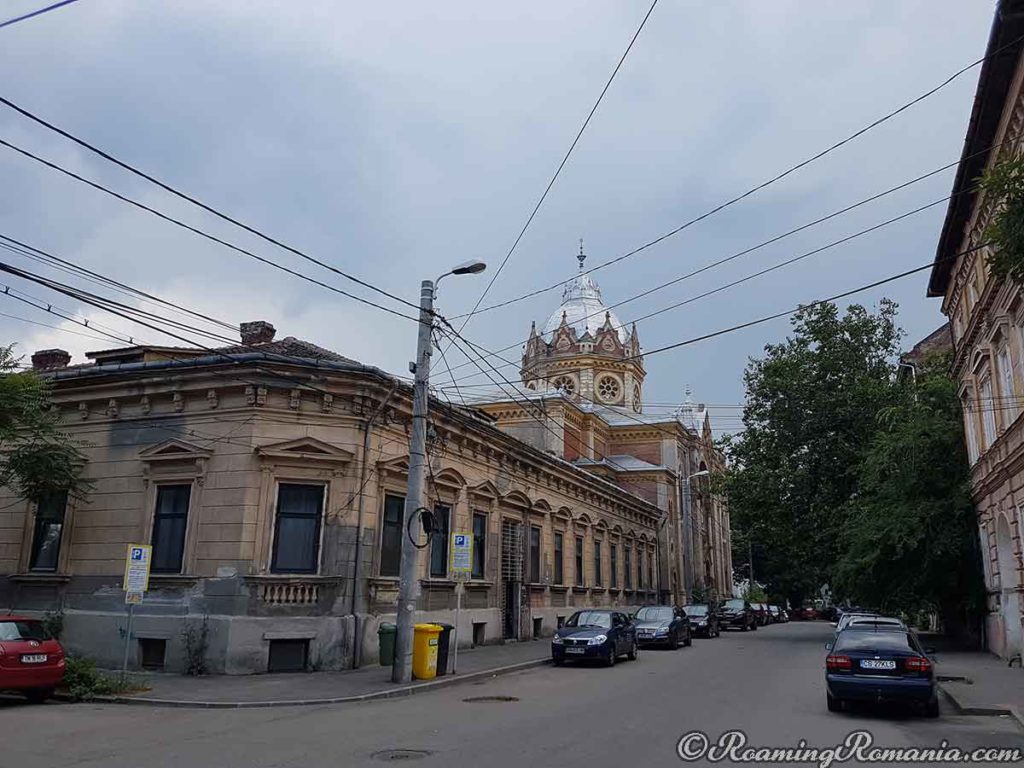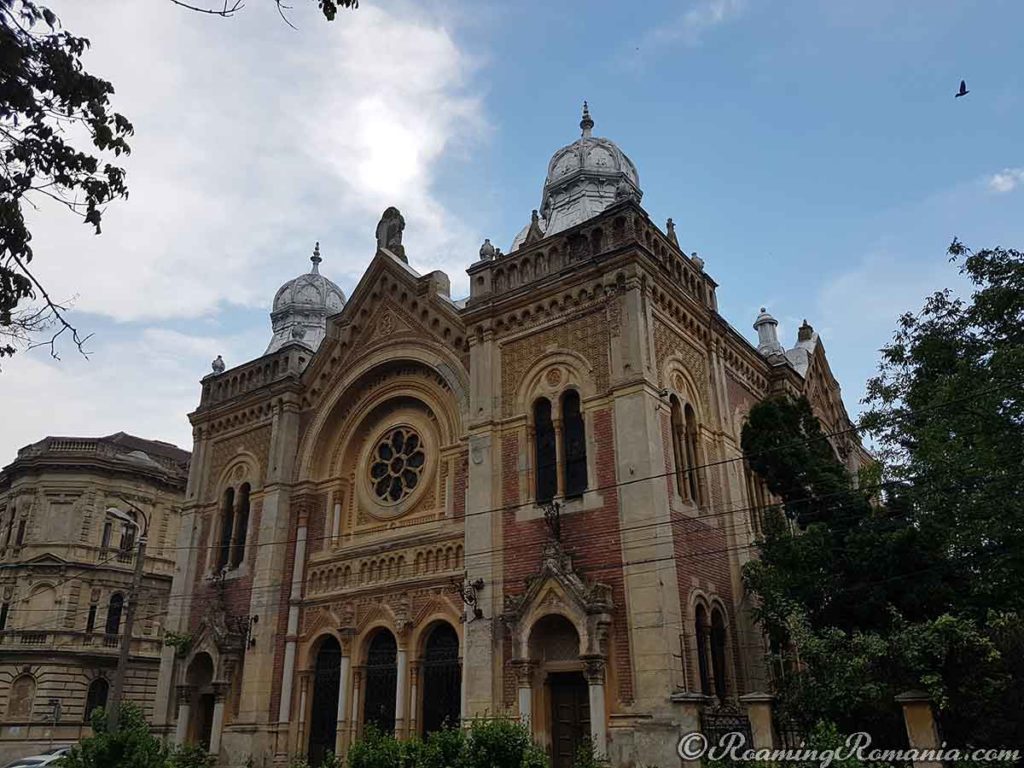Fabric Synagogue Timisoara – Summary
The Fabric Synagogue (Sinagoga din Fabric) is a late 19th century Eclectic, Neo-Moorish (Moorish Revival) and Neo-Renaissance (Renaissance Revival) style Neolog Synagogue in Timisoara, Romania. The synagogue was designed by the renowned Hungarian architect Lipót Baumhorn and built between the years 1897 – 1899 by the local Timisoara developer Josef Kremmer. The building is designated a Romanian National Monument. The Fabric Synagogue, along with the Iosefin Synagogue, and the Cetate Synagogue, make up the three Jewish Synagogues of Timisoara.
The Fabric Synagogue is also known as the New Fabric Synagogue because it replaced a previous synagogue that once stood in a different section of Timisoara’s Fabric District. The original 19th-century synagogue was predominantly Jewish Orthodox for many years until it became Jewish Status Quo, and then Jewish Neolog in 1879. It was the Neolog Judaism denomination that went on to build the New Fabric Synagogue in order to fit the large and growing Jewish community in the Fabric District.
The synagogue has a long and fascinating history, from its inception to its funding and creation, its story coincides with much of the Jewish history of Timisoara. The building was created primarily with funds and donations from Jewish community members of the 19th century. A commemorative plaque was placed inside the New Fabric Synagogue in 1902 to honor Amalia Freund and Bernát Deutsch for their donation of the land where the Synagogue was built. The plaque is now located at the entrance of the Cetate Synagogue.
The New Fabric Synagogue, also known as Sinagoga Maură, served as a house of worship for the Jewish in the Fabric District of Timisoara for over 100 years, from 1899 until 1985 when it held its last service. Romanian being under communist rule, and mass emigration from Jews to Isreal after WWII played critical roles in the shutting down of the synagogue. Due to the buildings highly acoustic architectural design, there have been recent, ongoing, attempts to transform the synagogue into a theater.
Fabric Synagogue Timisoara – Table of Contents
- Fabric Synagogue Timisoara – History
- Fabric Synagogue Timisoara – Architecture
- Fabric Synagogue Timisoara – Present Day
- Fabric Synagogue Timisoara – Visitor Info
Fabric Synagogue Timisoara – History
Throughout the 17th century, the Jewish community in Timisoara was documented as being around 144 members, consisting primarily of Sephardic Jews. During the decades of Islamic Ottoman rule over the land, Jewish factions had restrictions on creating Synagogues or places of worship. After the Habsburg’s defeated the Ottomans in the early 18th century, the Jewish communities in Timisoara saw a gradual revival and reemergence in the city. Even though during this time the Jewish minority in the city was beginning to emerge from the shadows, they still didn’t have the same opportunities and resources as those of the Christian religions that were fast recolonizing the city.
The Habsburgs didn’t flat out ban or outlaw Jewish sects in the lands held by their empire. The new lack of rampant Jewish persecution in Timisoara allowed the Jews to practice their religion in rented out houses and buildings throughout the city. The primary location used by the Jewish community in the city for worship was a rented-out house which used to stand where today’s Dicasterial Palace of Timisoara is located. The Jewish community used the rented house for worship services for many years until around city administrators had it torn down to create what is today’s courthouse.
Timisoara’s First Synagogue
In the late 18th century Timisoara’s Jewish community consisted of two different sects, the Sephardic and the Ashkenazi. Around the year 1760, the city authorized the communities to build Timisoara’s first synagogue which would cater to both sects. That original synagogue’s interior was constructed with elements that accommodated each of the two community’s traditions. The synagogue was mentioned by Timisoara historian, and author, Johann Jakob Ehrler, in his 1774 book Banatul de la origini pînă acum (Banat from its Origins until Now), as being “a synagogue divided into two parts, one in the service of the Spanish Jews, and the other for the German Jews.”
Timisoara’s first synagogue was structured like that of most common Jewish synagogues. It contained a washroom with a basin for washing of the hands, a wardrobe room, a library full of holy books and scriptures, a prayer room with a separate balcony for women, and a Holy Ark, where the Torah was sheltered. The synagogue’s courtyard contained the ritual bath, butcher shop and ritual restaurant, the rabbi’s home, and the offices of the community leaders. During the Hungarian Revolution of 1848, the Synagogue was heavily damaged and went out of commission until it was restored in 1852 and used until 1865. After its closure members moved to the Cetate Synagogue.
Timisoara’s Fabric Synagogue
The Fabric Synagogue of Timisoara was built in 1899 to replace a smaller synagogue which was outgrown by the fast expanding Jewish community of the Fabric District. The community wanted to create a modern synagogue with larger dimensions than the previous one, and closer in distance to them than the one located in the Cetate District. To pay for the new construction the Jewish leaders held a lottery, many wealthy Jewish businessmen and entrepreneurs donated large sums and the required funds for the project were fast allocated.
The land where the New Fabric Synagogue was built was acquired by the Status Quo ritual community of Fabric by a donation from Amalia Freund, and the former president of the Jewish community in Fabric, Bernát Deutsch. The synagogue was inaugurated on September 3, 1899, at a grand ceremony that was attended by Timisoara’s mayor, Carol Telbisz, and led by Rabbi Dr. Jacob Singer. The Fabric Synagogue went on to serve the Jewish community for many decades until WWII broke out and many Jews fled from Timisoara to Israel.
After the second world war, Timisoara’s Jewish population, which reached over 13,000 in the 18th century, was greatly reduced to just hundreds. The remaining Jews that lived in Timisoara didn’t have the resources and potential to continue running the Synagogue so they closed it in 1985. Over the years after its closure, the Synagogue has been broken into, robbed, and vandalized on numerous occasions. The Thieves who broke in stole and stripped out virtually everything that had any value to it. They took everything from the furniture to holy scriptures, to nails and screws that held the interior together.
Fabric Synagogue Timisoara – Architecture
The designer of the Fabric Synagogue was the famous Hungarian architect Lipót Baumhorn, nicknamed “the Father of the Synagogue.” Baumhorn is famous for designing a multitude of Synagogues throughout central Europe, as well as famous buildings in Timisoara like the city’s Lloyd Palace, and Water Palace. He designed the Fabric Synagogue according to the tradition of the great contemporary neologous of the end of the 19th century. The synagogue has a similar shape and dimension to those that were found throughout the Austro-Hungarian Empire, such as in ones in the cities of Rijeka, Szolnok, and Zrenjanin.
The Fabric Synagogue was designed in the Eclectic style and incorporates Neo-Moorish, Gothic, and Italian neo-Renaissance elements. The building has two right angle façades, each with its own separate entrance for men and women. The men’s entrance is through a vestibule and leads into the main body, the women’s entrance leads to a staircase that ends on the second story balcony. The main entrance contains a massive wrought iron gate that is accessed through three arches. Directly above the main entrance, there is a large stained-glass rosette window that illuminates the synagogue’s entrance lobby.
The New Fabric Synagogue has an enormous central tower which compromises the dome of the synagogue’s main hall. The corners of the building also contain smaller towers shaped similarly to the main one. The façade is polychrome and alternates between yellow and red brick. The building’s outer walls are connected by semicircular arches. The walls have numerous first and second story stained-glass windows, as well as rosettes above the entrances and on the main tower. Inside the synagogue, there is a stunning organ that was crafted by Leopold Wegenstein, known as Romania’s most talented organ builder.
Fabric Synagogue Timisoara – Present Day
The Fabric Synagogue in present-day Timisoara is currently not in use and is found in a state of horrible degradation. In 2009 the building, owned by the Jewish community of Timisoara, was transferred to the Timisoara National Theater Organization in a contract that was to span 35 years. The contract was formed to enable the theater company the right to transform the synagogue into a theater where performances and shows were to take place. The contract stipulated that the theater company was not allowed to perform any shows that were demeaning or insulting to Judaism or shows that were lewd or obscene in general.
The contract between the theater company and the synagogue owners also stated that the building must be renovated within 7 years of its signing (by 2016). When the national theater took ownership of the synagogue they deemed its condition to be “extremely poor and in urgent need of attention.” The first step they took was to do a complete analysis of the scope of the building’s damage. They found the building’s roof had portions that were collapsed, interior walls and wood structures decaying and covered by mold, large amounts of graffiti and vandalism, and many of the stained-glass windows horribly broken.
The National Theater’s second steps, carried out parallelly, were the two-stage sanitation of the building, and the emergency repair of the roof. After these initial hygienic works were carried out and finished by 2010, the restoration of the synagogue came to a brutal halt once it arrived at Romania’s, typical, bureaucracy and corruption stage. In 2011 the Technical-Economic Council of the Ministry of Culture of Timisoara was provided the contract to transform the synagogue’s interior into a theater. The heads of the Ministry of Culture however never started the project, instead, money dedicated to the renovation ended up missing on numerous occasions.
Records show that from 2011 to 2017 the revolving door of Timisoara’s Ministry of Culture has had 10 different members who served as heads of the organization. New management has come and gone with the years, leaving with them have been funds allocated for the synagogues reconstruction. The only thing that’s remained the same through this time has been the lack of work started on the building. Currently, proponents in favor of attempting to continue the restoration are struggling to draft a proposal that seeks funds from the European Union to finish the project by 2021 when Timisoara is designated the European Capital of Culture.
Fabric Synagogue Timisoara – Visitor Information
Location
The New Fabric Synagogue is located in Timisoara’s Fabric District at the address: Strada Ion Luca Caragiale 1
Visitation
The Synagogue is open for visitation of its exterior year-round. Visitors are allowed to view and photograph the outside of the building, however, access to the inside of the building is strictly prohibited as it continues to wait in limbo to be renovated.
